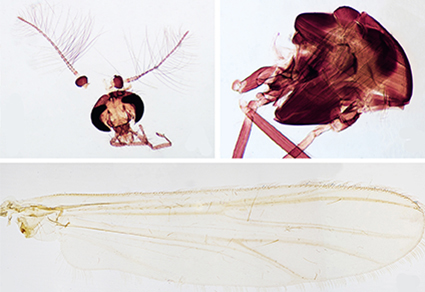Abstract
The genus Cryptochironomus has a cosmopolitan distribution including over 140 valid described species worldwide. The morphological characteristics and DNA barcode data of Cryptochironomus inflatus Liu, sp. nov. based on specimens collected from Oriental China. DNA barcode analysis including the partial COI sequences of species of genus Cryptochironomus is conducted. An updated key to adult males of the genus is provided.
References
- Anderson, A.M., Stur, E. & Ekrem, T. (2013) Molecular and morphological methods reveal cryptic diversity and three new species of Nearctic Micropsectra (Diptera: Chironomidae). Freshwater Science, 32, 92–921. https://doi.org/10.1899/12-026.1
- Beck, E.C. & Beck, W.M. (1969) Chironomidae (Diptera) of Florida III—The Harnischia complex (Chironominae). University of Florida Gainesville. Bulletin of the Florida State Museum Biological Sciences, 13 (5), 277–313. https://doi.org/10.58782/flmnh.pncg1122
- Curry, L.L. (1958) Larvae and Pupae of the Species of Cryptochironomus (Diptera) in Michigan. Limnology and Oceanography, 3(4), 427–442. https://doi.org/10.4319/l0.1958.3.4.0427
- Folmer, O., Black, M., Hoeh, W., Lutz, R. & Vrijenhoek, R. (1994) DNA primers for amplification of mitochondrial cytochrome c oxidase subunit I from diverse metazoan invertebrates. Molecular Marine Biology and Biotechnology, 3, 294–299. https://doi.org/10.4319/l0.1958.3.4.0427
- Hebert, P.D.N., Cywinska, A. & Ball, S.L. (2003a) Biological identifications through DNA barcodes. Proceedings of the Royal Society of London B: Biological Sciences, 270, 313–321. https://doi.org/10.1098/rspb.2002.2218
- Kieffer, J.J. (1918) Chironomides d’Afrique et d’Asie conservés au Musée National Hongrois de Budapest. Annales Historico-Naturales Musei Nationalis Hungarici, 16, 31–139.
- Giłka, W., Paasivirta, L., Gadawski, P. & Grabowski, M. (2018) Morphology and molecules say: Tanytarsus latens, sp. nov. from Finland (Diptera: Chironomidae). Zootaxa, 4471 (3), 569–579. https://doi.org/10.11646/zootaxa.4471.3.8
- Kumar, S., Stecher, G. & Tamura, K. (2016) MEGA7: molecular evolutionary genetics analysis version 7.0 for bigger datasets. Molecular Biology and Evolution, 33, 1870–1874. https://doi.org/10.1093/molbev/msw054
- Lin, F.J. & Chen, Ch. S. (1999) The name list of Taiwan Diptera. Taiwan Fauna 1. Musuem, Institute Zoologische, Academic Sinicia, Taipei, 124 pp.
- Lin, X.L., Stur, E. & Ekrem, T. (2015) Exploring genetic divergence in a species-rich insect genus using 2790 DNA Barcodes. PLoS ONE, 10, e0138993. https://doi.org/10.1371/journal.pone.0138993
- Lin, X.L., Yu, H.J., Wang, X.H., Bu, W.J., Yan, C.C. & Liu, W.B. (2021) New or little-known Boreoheptagyia (Diptera, Chironomidae) in China inferred from morphology and DNA barcodes. ZooKeys, 1040, 187–200. https://doi.org/10.3897/zookeys.1040.66527
- Liu, W.B., Yao, Y., Yan, C.C., Wang, X.H. & Lin, X.L. (2021) A new species of Polypedilum (Cerobregma) (Diptera, Chironomidae) from Oriental China. ZooKeys, 1011, 139–148. https://doi.org/10.3897/zookeys.1011.59554
- Liu, W.B., Wang, C.Y., Tang, Y.N., Wang, Y., Pei, W.X. & Yan, C.C. (2024) Six new species of Cryptochironomus Kieffer (Diptera, Chironomidae) from the Nearctic region. ZooKeys, 1200, 275–302. https://doi.org/10.3897/zookeys.1200.119225
- Makarchenko, E.A., Makarchenko, M.A., Zorina, O.V. & Sergeeva, I.V. (2005) Preliminary data on fauna and taxonomy of Chironomids (Diptera, Chironomidae) of the Russian Far East. Vladimir Ya Levanidov’s Biennial Memorial Meetings, 3, 394–420.
- Ratnasingham, S. & Hebert, P.D.N. (2013) A DNA-based registry for all animal species: the barcode index number (BIN) system. PLoS ONE, 8, e66213. https://doi.org/10.1371/journal.pone.0066213
- Roback, S.S. (1957) The immature tendipedids of the Philadelphia area (Diptera: Tendipedidae). Monographs—Academy of Natural Sciences of Philadelphia, 9, 1–152.
- Sæther, O.A. (1969) Some Nearctic Podonominae, Diamesinae and Orthocladiinae (Diptera: Chironomidae). Bulletin of the Fisheries Research Board of Canada, 170, 1–154.
- Sæther, O.A. (1977) Taxonomic studies on Chironomidae: Nanocladius, Pseudochironomus, and the Harnischia complex. Bulletin—Fisheries Research Board of Canada, 196, 1–143.
- Sæther, O.A. (1980) Glossary of Chironomid morphology terminology (Diptera: Chironomidae). Entomologica Scandinavica Supplement, 14, 1–51.
- Sæther, O.A. (2009) Cryptochironomus Kieffer from Lake Winnipeg, Canada, with a review of Nearctic species (Diptera: Chironomidae). Zootaxa, 2208 (1), 1–24. https://doi.org/10.11646/zootaxa.2208.1.1
- Sasa, M. (1998) Chironomidae of Japan 1998. Institute of Environment and Welfare Studies, Kurobe-shi, pp. 156
- Sasa, M. & Kikuchi, M. (1995) Chironomidae (Diptera) of Japan. University of Tokyo Press, Tokyo, pp. 333 https://doi.org/10.7601/mez.46.255
- Sasa, M. & Ogata, K. (1999) Taxonomic studies on the chironomid midges (Diptera, Chironomidae) collected from the Kurobe Municipal Sewage Treatment Plant. Medicine Entomology Zoologische, 50, 85–104. https://doi.org/10.7601/mez.50.85
- Shilova, A.I. (1966) On the taxonomy of Cryptochironomus ex. gr. defectus Kieff. (Diptera, Chironomidae). Trudy Institut Biologii Vnutrennich Vod Bylusk, 12 (15), 214–238.
- Silva, F.L., Strixino, S.T. & Oliveira, H.R.N. (2010) New species of Cryptochironomus Kieffer, 1918 (Diptera: Chironomidae: Chironominae) from Brazil. Zootaxa, 2614 (1), 18–32. https://doi.org/10.11646/zootaxa.2614.1.2
- Song, C., Lin, X.L., Wang, Q., & Wang, X.H. (2018) DNA barcodes successfully delimit morphospecies in a superdiverse insect genus. Zoologica Scripta, 47, 311–324. https://doi.org/10.1111/zsc.12284
- Song, C., Wang, Q., Zhang, R., Sun, B. & Wang, X. (2016) Exploring the utility of DNA barcoding in species delimitation of Polypedilum (Tripodura) non-biting midges (Diptera: Chironomidae). Zootaxa, 4079 (5), 534–550. https://doi.org/10.11646/zootaxa.4079.5.2
- Townes, H.K. (1945) The Nearctic species of Tendipedini (Diptera, Tendipedidae =Chironomidae). The American Midland Naturalist, 34 (1), 1–206. https://doi.org/10.2307/2421112
- Wang, X.H. (2000) A revised checklist of Chironomids from China (Diptera). Late 20th Century Rarearch on Chimnomidae: Anthology from the 13th International Symponium on Chironomidae. Odwin Hoffrichter Shaker Veriag ed., Aachen., pp. 629–652.
- Xia, X. (2017) DAMBE6: New Tools for Microbial Genomics, Phylogenetics, and Molecular Evolution. Journal of Heredity, 108 (4), 431–437. https://doi.org/10.1093/jhered/esx033
- Yan, C., Liu, T., Cao, W., Zhao, G. & Liu, W. (2018) A review of the Japanese Cryptochironomus Kieffer, 1918 (Diptera, Chironomidae). ZooKeys, 771, 139–155. https://doi.org/10.3897/zookeys.771.24220
- Yan, C., Zhao, G., Liu, T., Guo, Q., Hou, Z., Wang, X. & Pan, B. (2016) A new record and two new species of Cryptochironomus Kieffer, 1918 from China (Diptera, Chironomidae). Zootaxa, 4208 (5), 485–493. https://doi.org/10.11646/zootaxa.4208.5.6
- Zorina, O.V. (2000) Fauna and systematics of the tribe Chironomini (Diptera, Chironomidae) of the south of Russian Far East. A.I. Kurentsov’s Annual Memorial Meetings, 2000, 101–120.


